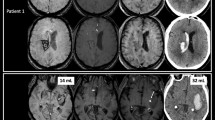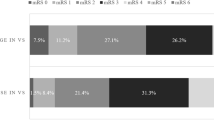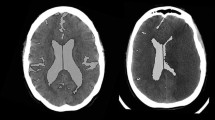Abstract
Background and Purpose
The perihematomal hyperintensity (PHH) is commonly interpreted to represent cerebral edema following intracerebral hemorrhage (ICH), but the accuracy of this interpretation is unknown. We therefore investigated the relationship between the changes in PHH and the changes in hemispheric brain volume as a measure of edema during the first week after ICH.
Methods
Fifteen individuals aged 66 ± 13 with baseline hematoma size of 13.1 ml (range 3–43) were prospectively studied with sequential MRI 1.0 ± 0.5, 2.6 ± 0.9, and 6.5 ± 1.0 days after spontaneous supratentorial ICH. Changes in hemispheric brain volume were assessed on MPRAGE using the Brain-Boundary Shift Integral (BBSI). Hematoma and PHH volumes were measured on T2-weighted images.
Results
Brain volume increased a small but statistically significant amount (6.3 ± 8.0 ml, 0.6 ± 0.7%) between the first and second scans relative to 10 normal controls (−0.9 ± 4.1 ml, P = 0.02) and returned toward baseline at the third scan (1.5 ± 9.5 ml vs. controls 0.9 ± 4.0 ml, P = 0.85). There were no significant differences in the volume changes between the two hemispheres at scan 2 or scan 3. At both scan 2 (P = 0.04) and scan 3 (P = 0.004), the change in PHH was significantly greater than and poorly correlated with the change in ipsilateral hemispheric volume. There were no significant correlations between the change in NIH Stroke Scale (NIHSS) and the change in PHH, ipsilateral, or total brain volume at scan 2 or scan 3 (all P > 0.05).
Conclusions
In patients with small-to-moderate-sized hematomas, change in PHH was a poor measure of brain edema in the first week following ICH. A small degree of bihemispheric brain swelling occurred, but was of little clinical significance.


Similar content being viewed by others
References
Arima H, Wang JG, Huang Y, Heeley E, Skulina C, Parsons MW, Peng B, Li Q, Su S, Tao QL, Li YC, Jiang JD, Tai LW, Zhang JL, Xu E, Cheng Y, Morgenstern LB, Chalmers J, Anderson CS. Significance of perihematomal edema in acute intracerebral hemorrhage: the INTERACT trial. Neurology. 2009;73:1963–8.
Inaji M, Tomita H, Tone O, Tamaki M, Suzuki R, Ohno K. Chronological changes of perihematomal edema of human intracerebral hematoma. Acta Neurochir Suppl. 2003;86:445–8.
Mayer SA, Sacco RL, Shi T, Mohr JP. Neurologic deterioration in noncomatose patients with supratentorial intracerebral hemorrhage. Neurology. 1994;44:1379–84.
Gebel JM Jr, Jauch EC, Brott TG, Khoury J, Sauerbeck L, Salisbury S, Spilker J, Tomsick TA, Duldner J, Broderick JP. Relative edema volume is a predictor of outcome in patients with hyperacute spontaneous intracerebral hemorrhage. Stroke. 2002;33:2636–41.
Zazulia AR, Diringer MN, Derdeyn CP, Powers WJ. Progression of mass effect after intracerebral hemorrhage. Stroke. 1999;30:1167–73.
Elijovich L, Patel PV, Hemphill JC III. Intracerebral hemorrhage. Semin Neurol. 2008;28:657–67.
Elliott J, Smith M. The acute management of intracerebral hemorrhage: a clinical review. Anesth Analg. 2010;110:1419–27.
Adeoye O, Broderick JP. Advances in the management of intracerebral hemorrhage. Nat Rev Neurol. 2010;6:593–601.
Sansing LH, Kaznatcheeva EA, Perkins CJ, Komaroff E, Gutman FB, Newman GC. Edema after intracerebral hemorrhage: correlations with coagulation parameters and treatment. J Neurosurg. 2003;98:985–92.
Wagner KR, Xi G, Hua Y, Kleinholz M, de Courten-Myers GM, Myers RE, Broderick JP, Brott TG. Lobar intracerebral hemorrhage model in pigs: rapid edema development in perihematomal white matter. Stroke. 1996;27:490–7.
Lee KR, Kawai N, Kim S, Sagher O, Hoff JT. Mechanisms of edema formation after intracerebral hemorrhage: effects of thrombin on cerebral blood flow, blood-brain barrier permeability, and cell survival in a rat model. J Neurosurg. 1997;86:272–8.
Keep RF, Xiang J, Ennis SR, Andjelkovic A, Hua Y, Xi G, Hoff JT. Blood–brain barrier function in intracerebral hemorrhage. Acta Neurochir Suppl. 2008;105:73–7.
Broderick JP, Brott TG, Duldner JE, Tomsick T, Huster G. Volume of intracerebral hemorrhage. A powerful and easy-to-use predictor of 30-day mortality. Stroke. 1993;24:987–93.
Kendall BE, Radue EW. Computed tomography in spontaneous intracerebral haematomas. Br J Radiol. 1978;51:563–73.
Olivot JM, Mlynash M, Kleinman JT, Straka M, Venkatasubramanian C, Bammer R, Moseley ME, Albers GW, Wijman CA. MRI profile of the perihematomal region in acute intracerebral hemorrhage. Stroke. 2010;41:2681–3.
Fox NC, Freeborough PA. Brain atrophy progression measured from registered serial MRI: validation and application to Alzheimer’s disease. J Magn Reson Imaging. 1997;7:1069–75.
Videen TO, Zazulia AR, Manno EM, Derdeyn CP, Adams RE, Diringer MN, Powers WJ. Mannitol bolus preferentially shrinks non-infarcted brain in patients with ischemic stroke. Neurology. 2001;57:2120–2.
Woods RP, Cherry SR, Mazziotta JC. Rapid automated algorithm for aligning and reslicing PET images. J Comput Assist Tomogr. 1992;16:620–33.
Freeborough PA, Woods RP, Fox NC. Accurate registration of serial 3D MR brain images and its application to visualizing change in neurodegenerative disorders. J Comput Assist Tomogr. 1996;20:1012–22.
Alemany RM, Stenborg A, Sonninen P, Terent A, Raininko R. Detection and appearance of intraparenchymal haematomas of the brain at 1.5 T with spin-echo, FLAIR and GE sequences: poor relationship to the age of the haematoma. Neuroradiology. 2004;46:435–43.
Ruscalleda J, Peiro A. Prognostic factors in intraparenchymatous hematoma with ventricular hemorrhage. Neuroradiology. 1968;28:34–7.
Knudsen KA, Rosand J, Karluk D, Greenberg SM. Clinical diagnosis of cerebral amyloid angiopathy: validation of the Boston criteria. Neurology. 2001;56:537–9.
Fishman RA. Brain edema. N Engl J Med. 1975;293:706–11.
Duning T, Kloska S, Steinstrater O, Kugel H, Heindel W, Knecht S. Dehydration confounds the assessment of brain atrophy. Neurology. 2005;64:548–50.
Yang GY, Betz AL, Chenevert TL, Brunberg JA, Hoff JT. Experimental intracerebral hemorrhage: relationship between brain edema, blood flow, and blood–brain barrier permeability in rats. J Neurosurg. 1994;81:93–102.
Xing L, Lee TY, Tamm A, Emery D, Jeerakathil T, Butcher K. Blood:brain barrier permeability is diffusely elevated in primary intracerebral hemorrhage [abstract 40]. Stroke. 2010;41:e200–53.
Powers WJ. Intracerebral hemorrhage and head trauma: common effects and common mechanisms of injury. Stroke. 2010;41:S107–10.
Suga S, Sato S, Yunoki K, Mihara B. Sequential change of brain edema by semiquantitative measurement on MRI in patients with hypertensive intracerebral hemorrhage. Acta Neurochir Suppl (Wien). 1994;60:564–7.
Jauch E, Gebel J, Salisbury S, Broderick J, Brott T, Kothari R, Tomsick T, Pancioli A, Barsan W. Lack of association between early edema and outcome in spontaneous intracerebral hemorrhage. Stroke. 1999;30:249.
Preboske GM, Gunter JL, Ward CP, Jack CR Jr. Common MRI acquisition non-idealities significantly impact the output of the boundary shift integral method of measuring brain atrophy on serial MRI. Neuroimage. 2006;30:1196–202.
Acknowledgments
The authors would like to thank Angela Shackleford, R.N., and the NNICU nurses for their help in performing the MRI studies. This study was supported by NIH (NS35966 and NS044885) and the H. Houston Merritt Distinguished Professorship of Neurology at the University of North Carolina at Chapel Hill.
Author information
Authors and Affiliations
Corresponding author
Rights and permissions
About this article
Cite this article
Zazulia, A.R., Videen, T.O., Diringer, M.N. et al. Poor Correlation Between Perihematomal MRI Hyperintensity and Brain Swelling After Intracerebral Hemorrhage. Neurocrit Care 15, 436–441 (2011). https://doi.org/10.1007/s12028-011-9578-8
Published:
Issue Date:
DOI: https://doi.org/10.1007/s12028-011-9578-8




